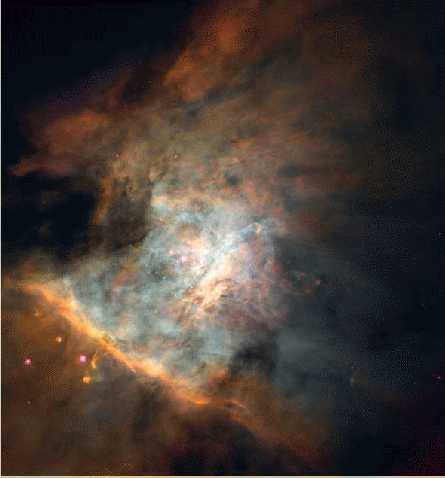The Birth
of a Star
The gas and dust clouds scattered in the interstellar space
are endowed with two properties: gravity and internal pressure or
temperature.
Gravity and Internal Pressure
In order to contract an isolated cloud free from external influences,
it's necessary that the gravity, responsible for the contraction, prevails over
the internal pressure, responsible for the scattering of the matter. Therefore,
at the temperature at which are found the clouds in our galaxy, it's estimated that 1000 solar
masses are necessary for one cloud to collapse. If the quantity of matter in
the cloud doesn't reach that value, then it's no longer enough to overcome the
pressure.

The Orion nebula: birthplace of
stars (C. O'Dell, S. Wong)
The Contraction
The giant cloud will split in smaller fragments that will give birth to
the stars. The process may still be eased by external factors, like the
collision with other clouds that provoke the compression of the matter and,
namely, with material proceeding from neighbouring supernovae.
The contraction of the matter will cause an increase of the density and
will make the temperature rise to 1 million degrees (ºK). Nevertheless, given
the transparency of the material, the energy released by the collapse is
constantly irradiated (particularly by the water molecules that it contains),
which keeps the cloud temperature at comparatively low levels and allows the
continuation of the contraction process.
Along with the irradiation of energy, they are also observed flows of
material ejected from the interior of the cloud, which counteract the action of
the material that is increasingly compressed inside the cloud.
When the density reaches even higher values, the cloud becomes opaque
and the energy is no longer irradiated to the space. The peripheral zones keep
contracting and, therefore, are responsible for the continuation of the
material and heat accumulation in the opaque zone.
Proto-Star
After about 100 000 years of contraction, when the temperature and
density reach even higher values, finally starts the nuclear
fusion of
the deuterium: a proto-star is born.

Proto-star, with a bipolar jet of matter
expelled from its closest neighbourhood (HST)
The Childhood of the Stars
When this material is exhausted, the collapse proceeds until the core
becomes hot enough to fuse the hydrogen into helium. It's estimated that,
during the collapse, the energy generated by it is transmitted to the surface
in a violent and discontinuous way, so that the star may display sudden
luminosity increases of as much as hundreds or thousands of times, during the
scale of some dozen days. These stars are called variable T-Tauri.
In the case of the Sun, the beginning of the hydrogen fusion occurred
after 10 million years of contraction, keeping contracting during the
subsequent 20 million years until it reached the stability that characterizes
it up to our days. The formation of smaller stars is generally slower than the
formation of the bigger stars.
Planetary Disks
Surrounding the young stars are frequently observed gaseous and dusty
disks that may well be the seed of planetary systems like the solar
system. They
are also observed holes in some of the studied disks, which may denounce the
presence of planets sweeping the primordial matter from their orbits. It's
estimated that the necessary period for a planetary system to form is about 10
million years.

Proto-planetary disks in the Orion
nebula (M. McGaughrean, C. O'Dell)
_